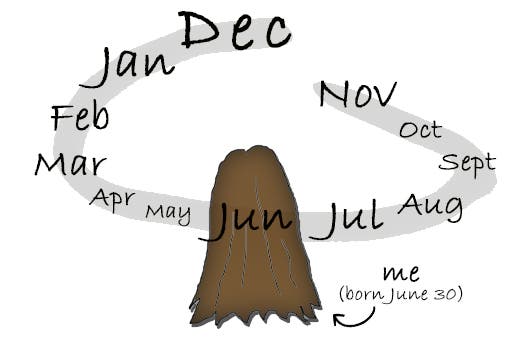
Synesthesia is an unusual neurological phenomenon in which the stimulation of one sensory pathway leads to automatic, involuntary experiences in a second. Imagine hearing the sound of a violin and instantly associating it with a specific taste. Imagine smelling something and associating it with the shape of a triangle. In synesthesia, all this becomes normal — and there are even more unusual forms.
Time space synesthesia, for instance, is relatively uncommon but very striking. People with this condition units of time (be it hours, seconds, or years) as occupying specific spatial locations. But it gets weirder.
Multisensorial sensations
The human brain is the most complex organ in the known universe. It houses around 100 billion neurons, and each neuron forms about 10,000 connections (synapses) with other neurons. It’s a vast network with unimaginable potential. It allows us to think, dream, and communicate with others. But it’s not perfect.
Synesthesia is one of the effects that can happen when the brain misfires. There’s much we still don’t know about synesthesia. However, researchers suspect it results from enhanced connectivity between sensory regions of the brain or a breakdown in the neural processes that separate the senses.
Basically, when some people get one sense stimulated, they involuntarily experience this stimulus in another sense. For instance, hearing a car horn causes some people to see the color green. Pop culture glorifies synesthesia. In movies or books, synesthesia often comes in as a metaphor used to convey the transcendence of the senses. But this condition is often misunderstood.
There are actually 54 forms of synesthesia. There’s the relatively common grapheme-color synesthesia, in which individuals see numbers or letters as inherently colored. For instance, a person might see the number “4” as red, or the letter “A” as yellow. There’s the rarer lexical-gustatory synesthesia, in which words induce a taste sensation. There’s also perhaps the weirdest of them all: time space synesthesia.
Time space synesthesia
People suffering from time space synesthesia (sometimes also called space time synesthesia) feel like units of time have a corresponding physical reality. Simply put, they can literally ‘see time.’
Here’s how Holly Branigan, a researcher at the University of Edinburgh, describes her synesthesia:
“For me it’s a bit like a running track. The track is organised around the academic year. The short ends are the summer and Christmas holidays – the summer holiday is slightly longer. It’s as if I’m in the centre and I’m turning around slowly as the year goes by. If I think ahead to the future, my perspective will shift,” Branigan told the BBC, describing a rough 3-D circle that surrounds her body and comes in her line of view whenever time organization is conjured.

The time circle is surprisingly common among the synesthetes.
For example, a person with this form of synesthesia might envision the months of the year as existing in a circular shape around their body. They may see the days of the week arranged in a row or some other distinct pattern. In the person’s perception, past years could be positioned on their left and future years to their right, or in some other distinct pattern. This phenomenon can also apply to smaller units of time, like hours or even seconds.
Psychologist David Brang from Northwestern University has been studying synesthetes for many years. He’s even looked at how you can induce short-term synesthesia in people. Brang says these subjects have time space synesthesia because they have extra neural connections between certain regions of the brain, allowing them to experience time as a spatial construct.
Brang has a lot to back this idea up. One of his study subjects, for instance, could see the year as a circular ring surrounding her body that rotates clockwise throughout the year. The current month, complete with the schedule, rested inside her chest, while the previous month floated in front of her chest. The data also seems to suggest this hypothesis. In one study, he showed that people with time pace synesthesia perform better at some geometrical and visual tasks.
Synesthetes performed better than controls on our test of mental rotation, but similarly to controls on tests of spatial and verbal working memory. Results support a dissociation between visuo-spatial imagery and spatial working memory capacity, and suggest time-space synesthesia is associated only with enhanced visuo-spatial imagery.”
Sensory perception and cognition research
Of course, this all boils down to people’s perceptions. It’s all in their ‘mind’s eye’, but make no mistake — it’s all very vivid. However, even synesthetes themselves don’t always realize what they’re perceiving.
In one study published in 2010, Brang recruited 183 students for a trial to identify the space-time synesthetes. Most of the time, a space-time synesthete has no idea his perception is rare and presumes everybody can experience time the way he does.
Brang’s volunteers were asked to visualize the months of the year and draw this representation on a computer. Four months later, they were shown a blank screen and asked to select the position for each of the months, as they previously drew them. They then were presented with a random cue, such as the position of one of the months in the calendar. Four of the 183 students then placed their months in a distinct spatial array, a circle, that was consistent with the initial trials. These four were clearly space-time synesthetes.

In a second test, Brang asked the subjects to memorize an unfamiliar spatial calendar and reproduce it. The space-time synesthetes far outperformed the others at this task, which wasn’t surprising given that their skill is correlated with a fantastic spatial and temporal memory. On average, people with synesthesia can remember 123 different facts relating to their lives, while a regular person can remember only 39.
Synesthesia may come with remarkable cognitive abilities
Other researchers have also found remarkable cognitive abilities associated with time space synesthesia.
University of British Columbia scientists found synesthetes were much faster than control groups at reciting the months of the year in chronological and reverse-chronological order, while another study found synesthetes have both superior autobiographical and visual short-term memory.
“So the average person might remember that they went on holiday to America when they were seven…. This person would recall the name of the guesthouse, the name of the guesthouse owner and the breed of the owner’s dog,” Julia Simner, a psychologist from the University of Edinburgh said.
In another study published in 2006, researchers from the University of Waterloo presented participants with a computer screen where the word “January” was traced right at the center. A small square then appeared somewhere on the screen, and each participant had to press the “spacebar” as soon they could detect it. The group of synesthetes could identify the targets much faster than the control group of non-synesthetes owing to their unique mental mapping of that particular month. This was all involuntary, subconscious.
Other researchers highlighted that “exceptional representations, such as of time, number, and space in synesthesia, can provide us with insights regarding the nature of the neurocognitive mechanisms of these dimensions, as well as their developmental, evolutionary, and cultural origins.” In other words, synesthesia can even help us understand how the brain functions.
The multisensory symphony of synesthesia
The unusual brain manifestations linked to synesthesia are pushing the boundaries of our understanding of human perception and cognition. From the colored letters of the grapheme-color synesthetes to the complex time-space constructs that some people see intuitively, synesthesia underscores the sheer diversity of the human mind. While it may be a neurological misfire, it also shines a light on the unimaginable potential our brains hold.
While it is easy to get lost in the awe and intrigue of these multisensory experiences, it is crucial to approach time space synesthesia (and synesthesia in general) with a scientific curiosity. As researchers continue to explore these fascinating conditions, we can look forward to a deeper understanding of the human brain and its incredible abilities.
Having synesthesia might seem like a lot of fun, but there are some downsides to it. There is evidence that suggests space-time synesthetes are more prone to develop Hyperthesmic Syndrome, which involves an inability to forget even the smallest details about the events of one’s life.
If you think you might be synesthetic, there’s an online questionnaire you can complete to find out here.



